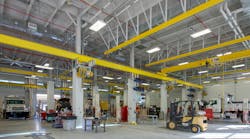Whether designing a new automotive or truck repair shop, or refurbishing an existing one, ventilation is always a concern, says Bruce Martin, sales manager, Plymovent Corp. Heating units, air conditioning, general ventilation exhaust fans, garage doors and air curtains at the doors all “have a large impact on operational cost and employee health and safety,” he says.
“An often overlooked component is a source capture vehicle exhaust removal system, such as those offered by Plymovent,” Martin says.
Plymovent (www.plymovent.com), an ISO 9001:2008 worldwide manufacturer of vehicle exhaust removal systems for various sectors, such as indoor fleet maintenance shops, military facilities, automobile plants and more.
While some facilities look upon these systems as simply a cost to be endured, a well-designed system can provide numerous benefits to both the owner and employees. Among them, reduced:
- Employee absenteeism
- Worker compensation claims
- Energy consumption from losing conditioned air by using overhead doors to ventilate a shop
- Maintenance costs of cleaning, painting, etc.
Vehicle Exhaust
It is well documented that gasoline exhaust fumes contain numerous hazardous chemicals, such as formaldehyde, benzene, acetaldehyde and particulate organic matter, as well as carbon monoxide, Plymovent’s Martin notes. The World Health Organization considers diesel exhaust a Group 1 carcinogen – meaning it has cancer-causing potential to humans, and it has no acceptable exposure limit, according to the National Institute for Occupational Safety and Health.
“The Occupational Safety and Health Administration’s hazard statement calls for tailpipe connected hose systems to fully capture and remove all exhaust fumes, along with a suitable general ventilation system with intake and exhaust fans,” says Martin.
What about “Clean Exhaust”?
“A common misnomer is that the current U.S EPA 2007-compliant diesel engines have clean exhaust,” says Martin of Plymovent. “Some truck salespeople have even said ‘It is safe to breathe the exhaust’ or ‘The air coming out of the tailpipe is cleaner than the air going in.’
“The technology used by these engines removes a large percentage of soot and nitrous oxides, but does nothing to remove the other toxic gases which are the major hazards still [present] in diesel exhaust. Just because you do not see the gray/blue plume does not mean hazards are not present.”
Another consideration is lawsuits.
America has become a litigious society and there are now lawyers who specialize in diesel exhaust exposure lawsuits, Martin says.
“Consideration should be given that the cost of installing a vehicle exhaust source capture system is far less expensive than a lawsuit or health insurance claim may be,” he says.
System Options
Exhaust systems come in many different forms, but generally categorized as overhead or in-ground systems.
Overhead systems can use hose drops, fixed extractors, hose reels or rail systems, all connected via galvanized steel ductwork installed at the building roof support level, with a fan either inside or out on the roof, explains Plymovent’s Martin. All of the equipment is surface mounted inside the building enclosure and is accessible as needed for service and maintenance.
Martin goes on to say that in-ground systems route PVC ductwork below the floor slab and the hoses are accessed via ports cast into the concrete floor. These systems require a sump pit to capture any shop liquids which find their way into the hose access ports and ductwork. Any liquid captured must be treated and removed as hazardous waste due to the possibility of oil, transmission fluid, antifreeze, etc., being present in the leachate.
Both systems use an exhaust fan to provide suction to move the vehicle exhaust fumes from the tailpipe through the hoses and ductwork. All fans should be built to Air Movement and Control Association’s Type B spark resistant construction standards, advises Martin. Depending on building design and customer preference, the fan can be located indoors or outside on the roof or side wall of the building.
Exhaust Volumes
A shop’s required exhaust volume depends on the vehicle and engine size being serviced. Generally, for automobiles in a typical automotive repair garage, the recommended volume is 250 to 300 cfm through a 4” hose, Plymovent’s Martin says. Exhaust volumes can go up to 700 to 750 cfm through 6” hoses for larger trucks.
“Experience has taught me that there is no hard and fast exhaust volume needed because every facility and shop is different,” he says. “This is where your product supplier comes into play, as he or she can make recommendations based on what you and your technicians actually do in your shop.”




